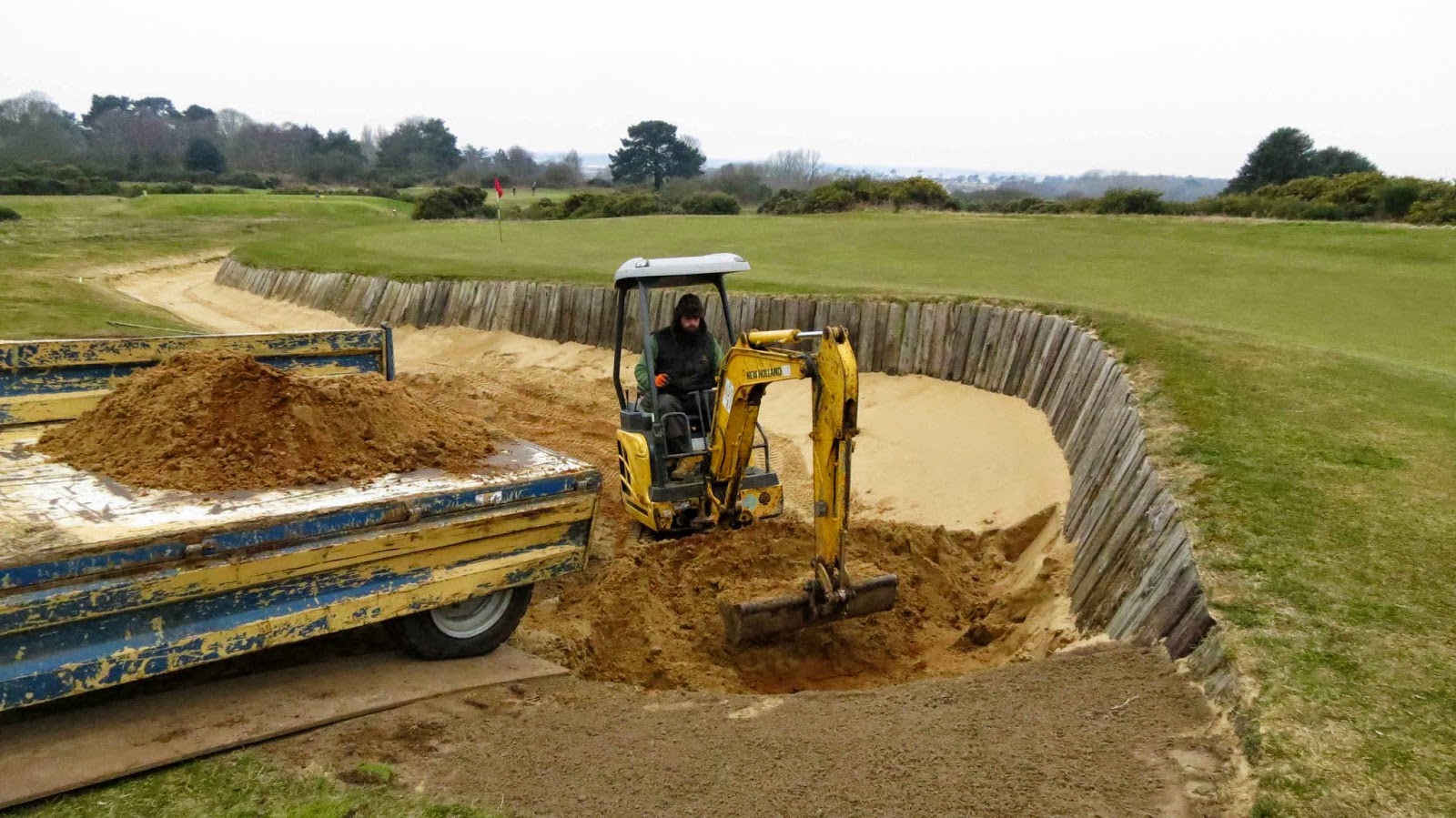 |
| Neil digging out stony subsoil on the 4th |
A blog about golf course and heathland management at Aldeburgh Golf Club and the wildlife found there. Aldeburgh GC is a top 100 championship course managed using traditional low input greenkeeping methods. It is situated on the Suffolk coast within the Suffolk Coast and Heaths AONB.
Wednesday, 18 February 2015
Bunker renovation
Over the last few weeks we've been re-shaping the bases of some bunkers and at the same time removing stony subsoil that migrates to the surface and contaminates the sand. We dig out the stony material (In some areas of the course the subsoil is more gravel than sand.) re-shape the base and put in a layer of stone free soil before topping up with sand. When shaping the base, we aim for a bowl shape with the lowest point about two thirds back from the bunker face, so that most balls will roll away from the face.
Management of the rough
We're currently doing work on the rough grassland areas flail mowing and collecting the clippings. To get a clear idea of the purpose of this work it helps to think of it as nutrient removal rather than mowing. By removing the clippings we reduce the nutrients available and this helps to develop finer grasses that thrive in impoverished soils. The aim is to develop wispy rough that enables errant golf balls to be found and makes playing a shot more difficult but not too difficult. Without intervention from mowing or grazing, the natural succession is from fine grasses to coarser grasses and then on to scrub followed by woodland. Clipping removal enables us to replace coarse grass with fine grass where necessary and to reverse or halt this succession process. In areas that already have fine rough cutting may only be required once every two to five years to maintain the current state but the coarsest areas on the course may be cut as often as twice per year.
The other important rough management task is the removal of invasive scrub and trees from the grassland. We aim to maintain a balanced heathland mosaic and without the removal of seedling trees and shrubs we would soon have a woodland golf course. This work is generally carried out during the winter months.
Whilst there are obvious benefits from this work in terms of playability and maintaining the heathland character of the course, there are also ecological benefits. The sparser sward that develops enables wild flowers such as harebell, sorrel and large thyme (it's actually quite small) to thrive. From an ecological standpoint the dry acid grassland that provides the ideal golfing rough is very desirable and improving this grassland is one of our targets within the environmental stewardship scheme we're participating in.
The other important rough management task is the removal of invasive scrub and trees from the grassland. We aim to maintain a balanced heathland mosaic and without the removal of seedling trees and shrubs we would soon have a woodland golf course. This work is generally carried out during the winter months.
Whilst there are obvious benefits from this work in terms of playability and maintaining the heathland character of the course, there are also ecological benefits. The sparser sward that develops enables wild flowers such as harebell, sorrel and large thyme (it's actually quite small) to thrive. From an ecological standpoint the dry acid grassland that provides the ideal golfing rough is very desirable and improving this grassland is one of our targets within the environmental stewardship scheme we're participating in.
 |
| Flail mowing and collecting the clippings |
Tuesday, 10 February 2015
Weather summary for January
The unusual thing about the weather this January was that there was nothing very unusual about it!
In recent years we've become accustomed to such extremes of weather that an average month comes as quite a shock. Rainfall was close to average with 51.6mm as was the mean temperature at 4.9°.
The lowest temperature recorded was -2.4° on the 20th and the highest was 14.6° on the 9th.
In recent years we've become accustomed to such extremes of weather that an average month comes as quite a shock. Rainfall was close to average with 51.6mm as was the mean temperature at 4.9°.
The lowest temperature recorded was -2.4° on the 20th and the highest was 14.6° on the 9th.
Subscribe to:
Comments (Atom)